Key Points
- SpaceX's new rocket exploded three minutes into the launch.
- The company had hoped to pull off a 90-minute debut flight into space but just shy of Earth orbit.
- The aim is that SpaceX's Starship will one day fly people to the Moon - or even Mars.
SpaceX's next-generation Starship spacecraft exploded minutes after liftoff in an uncrewed test flight from South Texas on Thursday, cutting short a key step in Elon Musk's development of a rocket vessel to eventually take humans to the moon and Mars.
The flight test was the first for Starship mounted atop the company's new Super Heavy rocket, and the first launch ever for that lower-stage booster, which SpaceX has touted as the most powerful launch vehicle on Earth.

Elon Musk watches the launch of inaugural test flight of Starship at the SpaceX launch facility in Boca Chica, Texas. A stuck valve delayed the launch by three days. Source: Supplied / SpaceX
While SpaceX officials were heartened by the outcome, the mission fell short of reaching several objectives.
The plan was for Starship to soar into space at least 150 km above Earth before it would re-enter the atmosphere and plunge into the Pacific near Hawaii. But the explosion cut the mission short.
Musk, SpaceX's founder, chief executive and chief engineer, had appeared eager to temper expectations in remarks made Sunday that downplayed the odds of a successful first flight. SpaceX President Gwynne Shotwell told a conference in February that the "the real goal is to not blow up the launch pad."
By that measure, the debut flight of Starship with its booster rocket represented a milestone in SpaceX's ambition of sending astronauts back to the moon and ultimately to Mars, as a major partner in Artemis, NASA's newly inaugurated human spaceflight program.
NASA chief Bill Nelson congratulated SpaceX on Twitter, saying, "every great achievement throughout history has demanded some level of calculated risk, because with great risk comes great reward."
What happened during the SpaceX launch?
The two-stage rocket ship, standing taller than the Statue of Liberty at 120 metres, blasted off from the company's Starbase spaceport on the southern tip of Texas along the Gulf Coast east of Brownsville. SpaceX hoped, at best, to pull off a 90-minute debut flight into space but just shy of Earth orbit.
A live SpaceX webcast showed the rocket ship rising from the launch tower into the morning sky as the Super Heavy's Raptor engines roared to life in a ball of flame and billowing clouds of exhaust and water vapor.
But less than four minutes into the flight, the upper-stage Starship failed to separate as designed from the lower-stage Super Heavy, and the combined vehicle was seen tumbling end over end before blowing apart.
The spacecraft reached a peak altitude of 37 km before its fiery disintegration, which SpaceX described in a live tweet as "a rapid unscheduled disassembly before stage separation." The company also noted that the rocket reached the critical launch point of maximum aerodynamic pressure before appearing to lose control.
It was not immediately clear whether the explosion was caused by the spacecraft's automated flight-termination system, which is triggered onboard when the rocket begins to show signs of failure.
Nevertheless, SpaceX officials on the webcast hailed the liftoff as a welcome accomplishment.
What did SpaceX learn from the launch?
Musk, shown seated in the Starbase mission control room in Boca Chica, Texas, wearing a headset, said on Twitter afterwards that the next Starship test launch would be in a few months.
"Congrats @SpaceX team on an exciting test launch of Starship! Learned a lot for next test launch," he tweeted. Musk, who purchased Twitter last year for $44 billion, is also CEO of electric carmaker Tesla Inc.
SpaceX principal integration engineer John Insprucker, one of the webcast commentators, said the experience would provide a wealth of data to inform further flight tests.
Webcast host and fellow SpaceX engineer Kate Tice said it appeared that three of the Super Heavy's 33 raptor engines "were out" during liftoff, but that could not be immediately confirmed.
The road to Thursday's accident has not been without previous tests and setbacks.
A stationary test firing of the Super Heavy while bolted to a platform managed to ignite just 31 Raptor engines in February, and an earlier static firing test in July 2022 ended with the vehicle's engine section exploding.
Before that, SpaceX had test-launched prototypes of Starship's top half in five short flights to an altitude of 9.7 km, seeking to perfect its return landing capability. All but one crashed in flames.
Still even a textbook test flight would have by design ended with crash landings of both portions of the spacecraft at sea.











